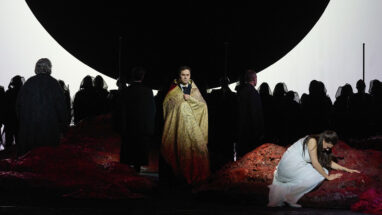
Simon Boccanegra: synopsis
Get to know the characters, events and the many intertwining plots of Giuseppe Verdi’s opera Simon Boccanegra.
characters
Simon Boccanegra, a corsair and the newly elected Doge of the Republic of Genoa
Jacopo Fiesco, a Genoese nobleman, also known as Andrea Grimaldi
Paolo Albiani, the Doge’s favourite courtier
Pietro, a Genoese popular leader
Amelia (Maria), Simon Boccanegra’s daughter, Jacopo Fiesco’s niece and foster daughter, also known as Amelia Grimaldi
Gabriele Adorno, a Genoese nobleman
The Captain
The Maid
synopsis
Prolog
It is 1339 and the people of Genoa, tired of factional infighting between the Guelphs and the Ghibellines, propose to elect a Doge to consolidate the republic’s fortunes. Paolo and Pietro, plebeian leaders, want former pirate Simon Boccanegra as their candidate. Boccanegra only accepts because he believes he can use the position to marry Maria, daughter of the patrician Jacopo Fiesco, who has imprisoned her since she bore Boccanegra a child. Fiesco emerges from his palace, mourning his daughter, who has died. Unaware of Maria’s death, Boccanegra offers an olive branch, but Fiesco refuses unless he is given custody of his granddaughter. Boccanegra explains that the girl has disappeared. Alone, he rushes into the palace and discovers Maria’s lifeless body just at the moment he is elected Doge.
Act I
A garden in the Grimaldi palace, sunrise. Twenty-five years have elapsed. Boccanegra has exiled many of his political opponents and Fiesco now lives outside Genoa under the name of Andrea Grimaldi. He is guardian to Amelia who, at sunrise, waits for her lover, Gabriele Adorno. She tells him that Boccanegra wants her to marry his courtier, Paolo. She also tells him that she is not a real Grimaldi, but an orphan. Adorno is determined to overthrow the Doge.
Boccanegra arrives and, in a moving duet, discovers that Amelia is his long-lost daughter. They embrace. Boccanegra tells Paolo to give up any hope of marrying her.
The council chamber. While negotiating a treaty between Genoa and Venice, the Doge is interrupted by a baying mob who storm the council chamber. An angry Adorno charges Boccanegra with abducting Amelia, who has disappeared. Just as he tries to stab Boccanegra, Amelia appears and steps between them. She pleads with the Doge to forgive Adorno and describes her abduction without naming the culprit. Boccanegra makes an impassioned appeal for peace and charges Paolo, as his state official, to curse the man responsible for the kidnap. Terrified, Paolo – who was behind the abduction – curses himself.
Act II
The Doge’s apartments. A vengeful Paolo pours poison into Boccanegra’s carafe of water. Paolo tries to persuade Fiesco and Adorno to assassinate the Doge. Fiesco refuses, but Gabriele, in a fit of jealousy, resolves to kill him. Amelia asks her father to pardon Adorno. He agrees. Alone, he drinks a glass of water and falls asleep. Adorno returns, but before he can kill Boccanegra, Amelia appears and the truth about her being the Doge’s daughter is revealed. Adorno swears allegiance to Boccanegra as rebellious cries are heard outside the palace.
Act III
The Doge’s Palace. Genoa celebrates Boccanegra’s victory over the rebels. Paolo is condemned to death. On the way to his execution, he gloats to Fiesco that he has poisoned the Doge. Boccanegra staggers in, gravely ill. He and Fiesco are reconciled when the Doge tells him that Amelia is his granddaughter. With his dying breath, he blesses the wedding of Amelia and Adorno. Fiesco announces Boccanegra’s death.
the multiple plots of the opera
1. The connection between Boccanegra and Fiesco
Besides their struggle for power, their antagonistic relationship stems from Boccanegra’s past involvement with Fiesco’s daughter, Maria, who has borne Boccanegra’s child. Consequently, Fiesco has confined Maria within his home, preventing Boccanegra from visiting her.
2. The fate of Boccanegra and Maria’s child
The child is named after her mother, so in the prologue, the name Maria refers to Fiesco’s daughter, while later it refers to Boccanegra’s daughter. The name is important: as the granddaughter is also called Maria, at the end Fiesco can feel like he has regained his daughter.
Boccanegra has arranged for the child to be cared for by an elderly woman, but as the woman dies, the child goes missing. Coincidentally, she ends up as the foster daughter of Fiesco, who is unaware that he is looking after his own granddaughter. Adding to the confusion for both the audience and the characters is that, from the first act, Fiesco adopts the name Andrea Grimaldi while the missing Maria is known as Amelia Grimaldi. For some reason, Maria’s true identity remains hidden almost until the end of the opera, though it is revealed to Boccanegra in the first act.
3. The relationship between Amelia, also known as Maria, and Gabriele Adorno
Amelia and Gabriele Adorno are lovers. Adorno is unaware of his beloved’s family connections and sees Boccanegra as his enemy and as a rival for Amelia’s affections.
4. The relationship between Paolo and Boccanegra
Paolo is initially Boccanegra’s favourite, but when Boccanegra rejects his proposal to marry Amelia, he turns against Boccanegra. This hostility leads him to orchestrate Amelia’s abduction and Boccanegra’s assassination.
The intertwining plots add complexity to the story, but in the resolution, all strands are successfully tied together as follows:
- Fiesco and Boccanegra make peace upon the revelation of their family connection.
- Amelia’s true identity is revealed to everyone.
- Gabriele and Maria are free to marry following the reconciliation
- The rebellious Paolo is sentenced to death, but not before he has managed to poison Boccanegra.
Text JUHANI KOIVISTO
Synopsis MARK PULLINGER
Simon Boccanegra at the Finnish National Opera 22.3.–26.4.2024.

